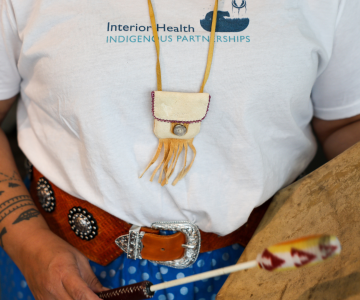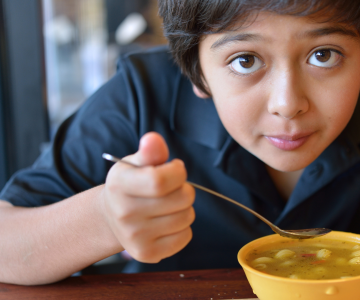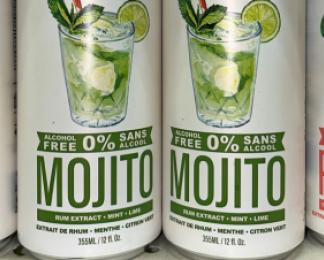Tobacco & Vaping Information for Teens
Teens make decisions that have impacts on their health. Tobacco and vaping affects you and the world around you.

Tobacco is a plant, considered sacred by many Indigenous peoples and used in its natural form in ritual, prayer and ceremonies. The non-traditional use of tobacco includes smoking (cigarettes, hookahs, cigars, pipe), using it in your mouth (chewing tobacco, pouches), or inhaling it (snuff). Tobacco contains nicotine, which is a highly addictive substance. Commercial tobacco also has many other harmful substances, which can have serious health impacts, especially when burned.
Vaping is the use of an electronic device to heat a substance (usually a vaping liquid, or “juice”) into an aerosol (a.k.a. vapour or cloud) which is then breathed in and out. Vaping products have either nicotine or cannabis. These substances get absorbed through the lungs and mouth when breathed in. Vaping devices come in various shapes and sizes. Although vaping is thought to be less harmful than smoking, it is not harmless. The “vapour” contain chemicals and heavy metals that can harm a person’s lungs and cause other health problems. Nicotine can also cause addiction and affect a teen’s brain development.
Visit the Foundry Cannabis Page to learn more about cannabis
Nicotine pouches are small, soft packets filled with nicotine, flavorings, and other chemicals. Unlike chewing tobacco or cigarettes, they don’t have tobacco leaves. The pouches are placed between the lip and gum, where they slowly release nicotine, which gets absorbed into the body through the mouth.
Even though they’re not smoked, pouches can still be harmful and addictive—especially for young people, because nicotine can affect brain development. In B.C., nicotine pouches are regulated and are meant to be sold behind pharmacy counters to protect youth’s health.
Teens choose to use nicotine products for many reasons. Sometimes people try it because they are curious, bored or because people they know or admire do it. Some people also feel that tobacco and vaping help them relax or cope with stress.
People also choose to vape or use nicotine pouches as a way to quit smoking, which is not recommended for teens. Others may choose to use these products because they think they are safe and harmless, which is not the case.
There are some other factors that can influence people to use nicotine products, like the industry’s marketing tactics, seeing influential people or characters using it, pressure to fit in and even a person’s life circumstance. A common misconception is thinking “everyone is using it” when in fact, most teens haven’t even tried these products.
The tobacco and vaping companies (often the same corporations) use aggressive marketing tactics that target racial and ethnic minorities, low-income populations and young people. In the past, tobacco companies promoted cigarettes as harmless, even though they knew smoking caused disease, so it is worth it to ask yourself: “What are these industries really trying to sell?”
Risks & consequences
Using tobacco or vaping creates health risks for the person using it and those around them. It also harms the environment and contributes to pollution and climate change. Check out the risks involved in using these products.
The DeNoble Files: e-Cigarettes
Nicotine is a highly addictive substance found in vaping, tobacco and oral products (like nicotine pouches). That means people who use it often need to increase the amount of nicotine they use to feel the same effects. Eventually they may feel unwell if they don’t use it, experiencing cravings, feeling moody, having headaches and trouble sleeping, for example. These are what we call withdrawal symptoms.
The amount or frequency of using nicotine needed to become dependent varies from one person to another, but we know that the earlier someone starts using nicotine, the higher their chances of becoming dependent. Nicotine dependence appears in the form of cravings, feeling like you need it to go about your day, and finding it difficult to resist using it even when you don’t want to or are in places where you shouldn’t use it. Some factors that influence a person’s chances to become dependent on nicotine are:
- Genetics: how their brain responds to nicotine
- Age: because teens’ brains are more vulnerable to nicotine, the younger someone starts using nicotine, the greater the chance they will develop nicotine dependency
- How they use nicotine: how often, how much and how deep they inhale (if smoking or vaping)
- If they are surrounded by people that smoke and/or vape
- If they have mental health issues
- If they use other addictive substances
Nicotine also alters a young person’s brain. Brains don’t fully develop until the mid 20s! The early use of nicotine can affect attention, learning, mood, and the ability to control impulses. It also increases the risk of developing an addiction to nicotine and other substances.
The effects of smoking commercial tobacco has been studied for decades now, so we know a lot about its health impacts. Other than nicotine addiction, we know that over time smoking can cause:
- Lung damage and disease
- Various types of cancer (lung, throat, stomach, bladder, kidney and more)
- Heart disease
- Stroke
It also increase the chances of developing:
- Diabetes
- Gum disease
- Yellow teeth
- Infections
- Skin problems
- Weaker bones
- Ulcers
- Fertility and reproductive problems
Smoking around other people or in closed spaces also affects their health. Second-hand smoke (smoke in the same air) and third-hand smoke (smoke that deposits in surface like clothing, furniture, carpeting, etc.) exposes people to many harmful chemicals that can cause them to have health problems.
Besides smoking, other tobacco products can cause health problems and be just as addictive as smoking. Using smokeless tobacco can lead to:
- An increased risk for pancreatic cancer
- White patches or red sores in your mouth that can turn into mouth cancer
- Dental problems, tooth loss and gum disease
There are still many things we do not know about vaping because it has not been around for very long. What we know is that, compared to smoking, vaping seems to be less harmful to a person’s physical health. It is, however, not harmless and creates a high risk for nicotine addiction. Here are some of the health concerns of vaping:
- Vaping can cause problems such as sore mouth or throat, cough, shortness of breath, and nausea, even when used for a short time.
- Vaping exposes people to many chemicals and heavy metals, some known to be harmful.
- Vaping affects a person’s heart, increasing the odds of developing heart and vascular diseases.
- Vaping is associated with various lung and breathing problems.
- Some people have suffered from severe lung illness from vaping.
- Vaping high concentrations of nicotine or too frequently, or ingesting the vaping liquid can cause nicotine overdose. Depending on how much, you may feel unwell (a.k.a. feeling nic-sick) or even experience nicotine poisoning, which may need medical attention.
- Vaping liquids can be absorbed through the mouth and skin and cause nicotine poisoning, especially to young kids and pets.
- Although rare, defective vapes have caused fires and explosions that resulted in serious injuries.
- Vaping near other people or in closed spaces may expose them to the chemicals from the vapour and harm their health. Early research shows people may experience breathing problems from the second-hand vapour.
The best way to protect yourself from the harms of these products is to stay tobacco and vapour free or quit as soon as possible. For people who choose to try or use tobacco and vaping products and those who are not ready to quit, here are some ways to minimize the risks of these products:
- Delay trying or using these products as much as possible. A teen’s brain is more at risk for developing nicotine dependence and it can alter your normal brain development.
- Limit the amount of nicotine you use to reduce the risk of addiction and exposure to harmful substances. You can do that by limiting the amount of cigarettes and vaping products you have on you, restricting the times and days you allow yourself to use it, and choosing products with lower nicotine content.
- Learn to manage your cravings. Try a distraction, taking a walk, chewing gum or breathing exercises. Cravings usually pass within five minutes.
- If you vape, use only devices that have been approved for sale in Canada and do not make changes to your products. Illegal and unregulated products do not follow safety controls and can be dangerous.
- Using both cigarettes and vaping increases the risk of addiction and is more harmful than doing either one alone. Vaping, although not harmless, as far as we know is less harmful than smoking.
- Wash your hands well after handling vaping liquids and keep all containers closed to avoid spills and accidental contamination.
- Keep all tobacco, vapes and vape liquids out of the sight and reach of children and pets to avoid accidental poisoning.
- Smoke or vape away from other people and outdoors to avoid exposing them to second- and third-hand smoke and aerosol.
Commercial tobacco has a huge impact on our environment and on climate change - from the water, land and energy used to produce it, to the toxic littering in our environment, polluting land and water, and damaging entire ecosystems.
Tobacco production is also a big part of vaping, since the nicotine in vaping products is mostly extracted from tobacco leaves, with only a few companies using synthetic nicotine – a whole other topic of concern because we don’t know if it affects the body differently.
Because smoking leads to many diseases, people who smoke may also be more vulnerable to extreme weather events. Staying smoke and vape free not only reduces your environmental footprint but also helps you remain healthy and cope better with climate issues.
More information & resources
Here are some trustworthy websites where you can find more information and resources about tobacco and vaping.
Get Help Quitting
- Quash | Information and quit help app | Lung Health Foundation
- QuitNow | Information and quit support | BC Lung & Government of B.C.
- QuitNow | Your Vape-Free Life | BC Lung & Government of BC
- What is the Single Best Thing You Can Do to Quit Smoking? | Animated Video | Dr. Mike Evans
- Kids Help Phone Support | Free & confidential e-mental health service | Kids Help Phone
Tobacco
- Learn About Tobacco | Information page | Here to Help
- Respecting Tobacco | Traditional use of tobacco information and resources | FNHA
- Youth Respecting Tobacco | Information for youth | FNHA
- Smoking Information for Teens | Nemours KidsHealth
- Tobacco | Information page | Foundry
Vaping & E-cigarettes
- Clearing the Air Poster | A youth-led research project about vaping | McCreary Centre Society
- Consider the Consequences of Vaping | Health impacts information | Health Canada
- E-Cigarettes: What You Need To Know To Stay Healthy | FNHA
- Health information for youth | Health risks of vaping | Province of British Columbia
- Risks of vaping | Health Risks | Government of Canada
- Vaping | Health risks of vaping | HealthLink BC
- Vaping | Information page | Foundry
- Vaping information in BC | Risks, Services and legal information |Province of British Columbia
- Vaping: What you and your friends need to know | Information page | CAMH
Nicotine Pouches


In the 5 years since the In Plain Sight report was released, we’ve made strides towards being a culturally safe organization—but there’s more work to do.
/stories/ihs-fifth-plain-sight-response-supports-reconciliation


Inspired by her aunt’s career as a pharmacist, Angela became a pharmacy technician to use the hands-on aspect of compounding to benefit patient care.
/stories/we-are-ih-pharmacy-tech-enjoys-problem-solving-patients


Souper Meals brings students together once a week over locally made soup, fresh fruit, veggies and buns, all free of charge.
/stories/more-soup-benefits-universal-school-lunch-program


With decades of experience rooted in compassion and commitment to children’s health, Dr. Jeff Wong is carving a path for pediatric care at Kelowna Hospital.
/stories/dr-jeff-wong-leads-kelowna-pediatric-department-forward


The holidays season offers opportunities to drink alcohol, and it can be easy to overindulge. Get tips on how you can drink less - and live more.
/stories/holiday-spirit-tips-drinking-moderation-season


With the support of her mentors and coworkers, Niomi Wright found her true health-care calling as a care aide at Mountain View Lodge in Lillooet.
/stories/we-are-ih-care-aide-recognizes-value-mentors-and-colleagues
STAY CONNECTED
Receive news, alerts, public service announcements and articles right to your inbox.

